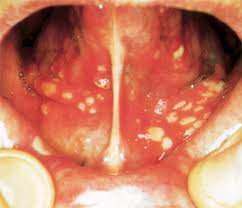What is an oral ulcer?

An ulcer in the mouth
An oral ulcer, or an ulcer in the mouth, is a painful lesion as a result of a complete break in the epithelium of mucous membrane. The body responds to this localized defect by producing fibrins, which fills and overflows in the ‘crater’ formed by the break in mucous membrane, giving it a bubble-like protrusion from the rest of the mucosa. The presence of fibrin gives it the yellowish colour which could easily be mistaken as pus.
What is the difference between an ulcer and an erosion?
An erosion is a break in the epidermal layer of epithelium, and is raw, red in colour; while an ulcer is a break in the entire epidermal and dermal layer of epithelium, and is yellowish in colour due to the presence of fibrin.
Causes of ulcer
This section has already been discussed in the article \”Causes of ulcers in the mouth\”.
Should I be concerned?
If your ulcers heal, then there shouldn’t be much to be worried about. However, it is still necessary to have the cause singled out so that any underlying cause can be addressed and treated accordingly. Once that underlying cause has been treated, the ulcers will also go away.
People usually only become worried and seek dental help when the oral ulcers are causing difficulties such as in eating, talking, and even cleaning their teeth. In recurrent aphthous stomatitis (RAS), there is no cure and the patient will continue to experience such symptoms possibly for their lifetime; this can be a great inconvenience to the individual. The dental professional’s role in such situations is to give suitable advice and prescribe certain medications to reduce the symptoms and make it more bearable.
When should I be concerned?
If your ulcer does not heal after several weeks or months, seek a dental professional’s help, as non-healing ulcers may suggest a malignancy. If a tumour is indeed suspected, a biopsy can then be done to further confirm the diagnosis. the earlier it is removed and treated, the better the prognosis (chance of survival).
What are the Investigations that can be done to identify the cause:
Generally, identification of the cause of ulcers can be done based on history taking and the clinical features. Your dentist may ask you questions such as :
- When did the ulcer first occur? (A history of an incidence or incidences since childhood suggests recurrence, which can be indicative of RAS.)
- How often does it occur? How long does it last? (This gives a clue as to whether it is a major or minor aphthous ulcer)
- Is there anything you did or took that you think may have caused the ulcers?
- Has it become better or worse since it first started?
- Are you currently taking any medication? (Some drugs can cause ulcerations)
- Do you have frequent episodes of abdominal discomfort? Do you have diarrhea often? (If the answer is yes, this may suggest an underlying gastrointestinal disturbances that could have caused mouth ulcerations.)
- Do you have sores or ulcers elsewhere in your mouth such as genitals or eyes (or itchy eyes)? (If yes, this could be indicative of Behcet’s disease.)
- Do you have any joint pains (eg in your hands, especially on waking up) recently? (This could suggest an underlying connective tissue disorder, like Rheumatoid arthritis)
- Did you have a symptoms like fever, or a tingling, pins-and-needles feeling on the sites of ulceration just before the ulcers appear? (this may be suggestive of herpes simplex virus infection)
During the clinical examination, your dentist will check for:
- the size of the ulcer
- the number of the ulcer
- the site of ulcer
- the colour of surrounding skin or mucous membrane
- whether your submandibular lymph nodes are palpable
- whether you have a sharp tooth or parts of dentures that could have predisposed to the occurrence of an ulcer
Some tests can be carried out to exclude or confirm an underlying systemic disorder:
- blood test-a full blood count (FBC) and ESR as a baseline investigation, Anti-Nuclear Antibody (ANA) and Rheumatoid factors (RF) to check for any connective tissue diseases,
- Tzanck smears, viral cultures
- Colonoscopy (an endoscope is used to view the colons for presence of ulcers)-this is only done if patient complains of frequent abdominal discomforts, episodes of diarrhea, and blood test produce results that may be indicative of a malabsorption disorder)
- Biopsy (if ulcers does not seem to be healing after about 3 weeks) to check for malignancy
- Patch or sensitivity testing
The treatment available will be further discussed in “About ulcer of the mouth-Part 2”

